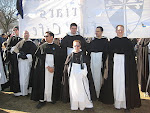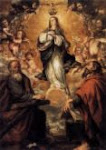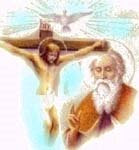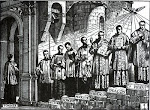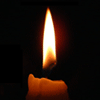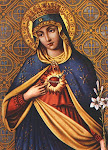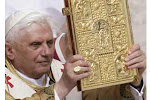http://www.stmarien-bethen.de/
If you would like to know more and use google translator
I spent the last ten days in Oldenburg, where I was born. My Mum was German and my father from South Wales. Notwithstanding my Mother being a German Lutheran, not in communion with the Catholic faith, I decided I would attend the church of Pilgrims in Cloppenburg, South of Oldenburg, which I found was buzzing with excitement because of the imminent visit of the Holy Father. At a time of such large scale apostasy in Europe, the visit of the successor of Peter was a sign of hope. The weather was terrible, but apparently on the major days of remembrance for Mary, many people walk from Cloppenburg to this site-also from Oldenburg I understand to thank her for co-operating with God to give our Saviour a human body. I was moved to wonder, whether Jesus looked like her.
Last Sunday was the Feast of the Assumption. Along with Enoch and Elijah, from the very earliest years of the Church was the tradition, that Mary, the Woman of Revelations 12 was taken body and soul into heaven to be with her Son, who loved her as we all love our Mothers. This Mother, who could have been stoned to death for agreeing to bear the Saviour whilst unmarried was the most Perfect Christian, giving God a body, then giving his Mother to be the Mother and Ikon of all His People. The Assumption was only made an official Dogma, after people started chipping away at this age old dogma.
On this day , there was a pilgrimage with all the people bringing herbs and wild flowers to the shrine. In German the words 'Heilkraut' are healing herbs, which the ladies brought there to give to Mary, to thank her for her role in giving birth to our Lord 'Behold the Handmaid of the Lord, Be it done to me according to Thy Word'. The priest told us, that Mary reminds us that we are flesh and blood humans, just as she was, and yet God can wreak enormous Love and Sacrifice from us too, and a call to Divinity, when we have Faith in and trust the Saviour and keep his Commandments in our struggle to be Holy and Members of His Body on Earth. It was also mentioned that Our Saviour loved us so much that he took on the frailty of our mortal bodies, nut he overcame it all to conquer death.
The Ark of the Covenant contained
The Torah-the Word of God
The Rod of Aaron-the symbol of the High Priest of God
The Manna -the physical food given to the Israelites in Canaan, when they were starving on the Way to the Promised Land.
Mary, the Ark of the New Covenant contained in our Blessed Saviour:
Jesus, the Word of God, in tradition of the early Apostles (St John tells us not all was written down about Jesus)
Jesus, the High Priest, King of all us Christians, called to be priests and evangelists of His Word.
Jesus, the Eucharist , who feeds us with his Body and Blood, when we are starving in the Wilderness of a world , living among some sinful and wicked people, who have turned away from Him and His teaching, and have renounced him and been led away from Truth.
Little Holy Mary, pray for us Sinners, that we may be made worthy of the Promises of Christ.Little, holy Mary may we all appreciate your tremendous act of Faith, and give us courage to carry on in our day to day lives, getting closer and closer to Jesus.
Podcast from St Maria Bethen Shortly.
Thursday, August 25, 2011
Monday, August 8, 2011
MARY ON HOLIDAY--THE HIDDEN CISTERCIAN GEM OF NETLEY ABBEY
As a guest on a yachting holiday to Cowes, in the Isle of Wight, we stayed at a village called Netley Abbey. Actually finding it was tricky but we managed with the help of a satnav! The whole village once belonged to the Abbey and indeed Netley Abbey is the most complete, surviving Cistercian monastic ruin in England, and an unexpected hidden gem in the middle of a small village and estate.The ruins show the remains of 800 years of change, from a Cistercian house to a mansion for one of Henry VIII's henchmen and finally it was sold for masonry and became a Romantic ruin. The Cistercians must have enjoyed a wonderful life of prayer in this setting overlooking the Solent!Now there is a hedge and it is protected by English Heritage.
The Abbey was founded by monks from nearby Beaulieu Abbey by Peter des Roches the powerful Bishop of Winchester in 1238 and there were 15 monks, but 30 lay brothers and other employees, officials and labourers.
In the sad years, when the king wished to marry his mistress, the Abbey was closed and taken by the king and sold at a knockdown price to his supporter in this venture Sir William Paulet. Who built a Tudor Courtyard palace on the site, using the buildings that were there in 1536. By the 18th century, repairs became too costly and by 1704 the house was abandoned to provide stone for building but painters, poets and writers arrived there, taking inspiration from the spiritual nature of the building.The Abbey was only saved, when work demolishing the Abbey was stopped, when a worker was killed.
Horace Walpole, Jane Austen and many others visited the Abbey, inspired by its grandeur-even as a shell. Northanger Abbey may have been inspired here, so close to the coast.It was a popular place for people from the nearby area to come and have ginger beer and a party, but by the twentieth century, antiquarian interest stopped such things and admiration for the gothic masonry of the abbey, made them remove all the vestiges of the Tudor mansion, which had decayed and restored it. It is now cared for by English Heritage, and a hidden gem in the rural landscape.All was still there, the book room, the kitchen, the enormous church.
For its short tenure by Sir William Paulet,from 1536 to 1704 , the death of the demolition worker and the giving up of the house for masonry, you have to ask whether the theft of the monastery was worth it, even for the vanity of one of the people charged with closing these houses of prayer-which often incorporated hospitals.... A sad chapter in our history.
If you are around Southampton, visit Netley, and see the hidden gem!
The Abbey was founded by monks from nearby Beaulieu Abbey by Peter des Roches the powerful Bishop of Winchester in 1238 and there were 15 monks, but 30 lay brothers and other employees, officials and labourers.
In the sad years, when the king wished to marry his mistress, the Abbey was closed and taken by the king and sold at a knockdown price to his supporter in this venture Sir William Paulet. Who built a Tudor Courtyard palace on the site, using the buildings that were there in 1536. By the 18th century, repairs became too costly and by 1704 the house was abandoned to provide stone for building but painters, poets and writers arrived there, taking inspiration from the spiritual nature of the building.The Abbey was only saved, when work demolishing the Abbey was stopped, when a worker was killed.
Horace Walpole, Jane Austen and many others visited the Abbey, inspired by its grandeur-even as a shell. Northanger Abbey may have been inspired here, so close to the coast.It was a popular place for people from the nearby area to come and have ginger beer and a party, but by the twentieth century, antiquarian interest stopped such things and admiration for the gothic masonry of the abbey, made them remove all the vestiges of the Tudor mansion, which had decayed and restored it. It is now cared for by English Heritage, and a hidden gem in the rural landscape.All was still there, the book room, the kitchen, the enormous church.
For its short tenure by Sir William Paulet,from 1536 to 1704 , the death of the demolition worker and the giving up of the house for masonry, you have to ask whether the theft of the monastery was worth it, even for the vanity of one of the people charged with closing these houses of prayer-which often incorporated hospitals.... A sad chapter in our history.
If you are around Southampton, visit Netley, and see the hidden gem!
Labels:
Cistercian Abbeys,
Netley abbey,
Southampton.
Subscribe to:
Posts (Atom)




